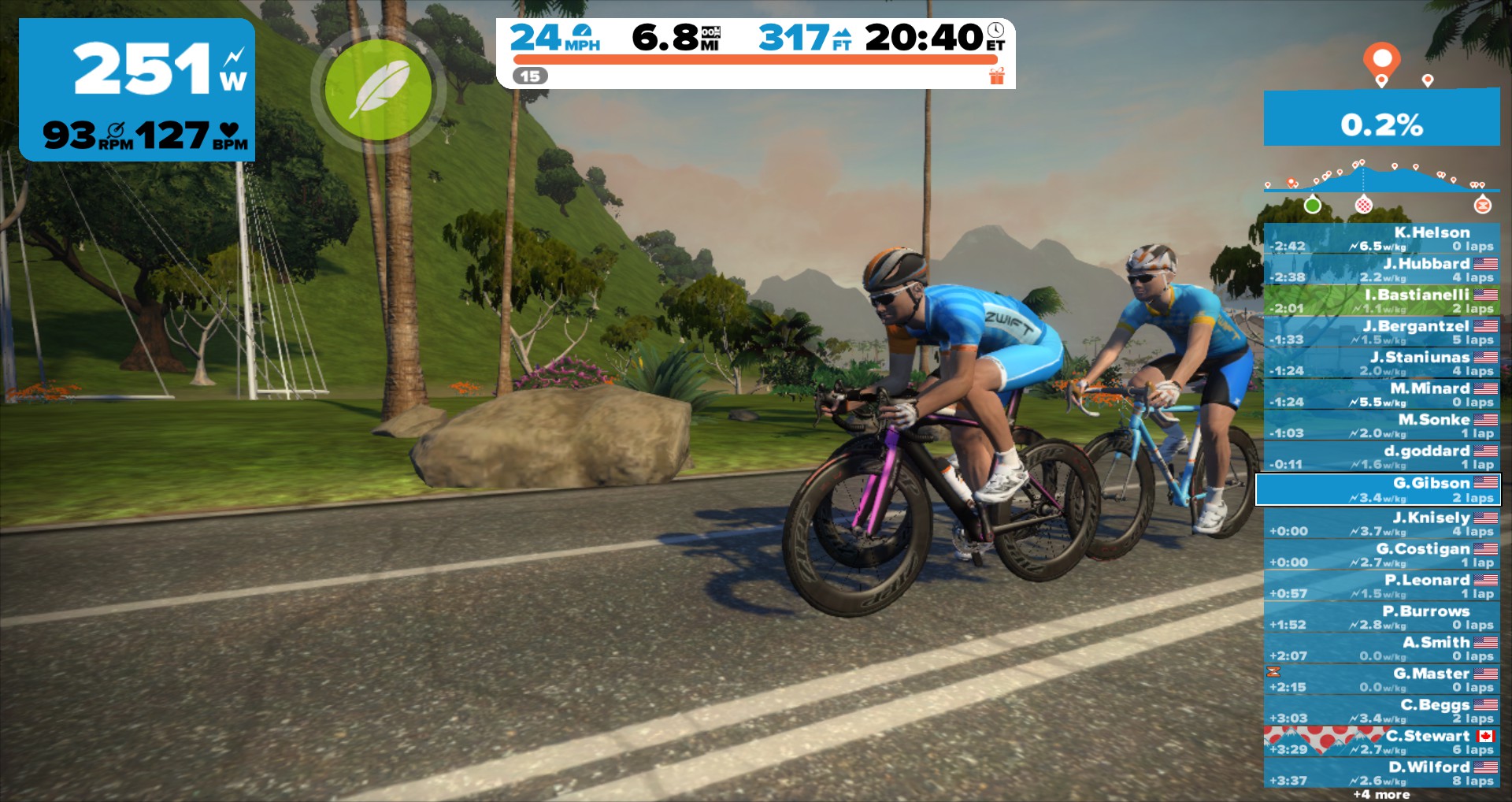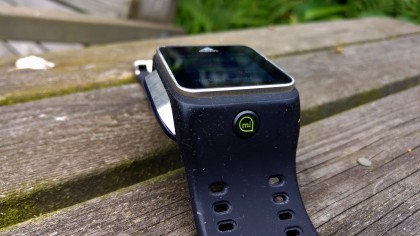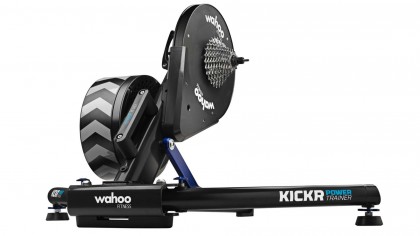How to challenge people in Fiji to a cycle race from your garage
My new runner isn't completely convinced by tech

I'm currently tapping this out in the back of my soon-to-be brother-in-law's car as he takes me and my (now) fiancée to the airport for a week in New York.
I'm sweating buckets because I tried to sneak in a quick interval run before we left, which meant I bolted in through the door with only a few minutes to go to disapproving looks and the fastest shower of my life.
I've definitely forgotten something important, I've got that post run 'I CAN'T STOP SWEATING' problem, no matter how much I tried to dry off, and I'm getting motion sick from trying to write – but I'm going to get this column to you on time, dear reader.
Hero? I wouldn't go that far.
This week has, once again, been terrible for training. Fresh from the painful hamstrings, I'm still not feeling confident that I can push things to the limit lest they twang and put me out for weeks.
Which means my strength and speed training still hasn't properly started, a mix of slower recovery runs sandwiching a non-run day on Wednesday. I was in Paris all day for work, which meant I was up at 4.45AM to board the Eurostar, but I was home by 8.30PM and could have made it out for a run – I'm still annoyed now.
With that in mind, I'm going to reboot the training plan when out in the Big Apple and hope that this one sticks. While I'm still not convinced by the MiCoach training plan, I'm going to start with it for a week just to get me literally back up and running after which I'll try and tailor it to add in some longer hill sessions and letting me do Parkruns.
Get daily insight, inspiration and deals in your inbox
Sign up for breaking news, reviews, opinion, top tech deals, and more.

I will say that I'm constantly impressed with the amount of development that happens with Adidas' SmartRun watch – I don't think it's sold in the millions and yet there are still updates every quarter with new functionality.
GPS is still a little slower to pick up than other Garmin smartwatches, but the heart rate monitor is pretty accurate and there's now a mode that switches the screen off to save battery.
It's still expensive at over £200 – but I strongly suspect Adidas is using this development to bring out another, improved, running watch, and the more brands doing that, the better.
Riding the mountains in my own garage
Despite taking delivery of this during the latter stages of the triathlon training, a quick glance at the instruction manual scared the life out of me in terms of getting it all set up.
However, with running off the cards at times in the last week, I looked for something else to do, so decided to finally get this sorted.
For those that don't know (which was me a few days ago), a turbo trainer is a replacement for your back wheel on your two-wheeler and turns it into a super exercise bike.
The Wahoo Kickr, used by the Team Sky cyclists to help them train through the disgustingly cold winter months, is one of the more complete options, bringing the ability to change resistance on the fly to mimic hills and provide total training.
It pairs with the Wahoo Fitness app through Bluetooth, meaning you can set up custom workouts or just see your speed or power output. However, I skipped that bit because I was too excited about trying it with Zwift, a massive online multiplayer world to cycle around against other cyclists.

But first, had to get the thing set up. The first thing to note is this thing is HEAVY – it's not something you can carry back from the shops. However given this thing costs just south of £1000, I'm comforted by the heft.
Set up is easy enough, if a little cumbersome. Snapping the legs into place takes a bit of grunt and getting it in a good place to see your tablet or laptop screen is tricky.
Then comes the spindown, where after 10 minutes warm up the Wahoo app asks you to speed up to 23MPH to calibrate the system. It was at this point I started to worry: my chain was skipping all over the place, and no amount of adjustment would stop it jumping gears.
After about 5 minutes I worked out what was wrong. My bike is an 8 speed on the read, where this was a 10 speed cassette – hence the derailleur skipping all over the place.
But I could work around that, and I was soon into the Zwift program. Macbook on a nearby shelf, I connected the Ant+ connector into the USB slot and let the program find the trainer. It also connected up to the TickrX heart rate monitor easily too, which was great.
After choosing my rider, bike and outfit, I was off, dropped in a virtual world where I could see my fellow cyclists on a map. It seems there's not a lot to do at the moment in that place, other than do laps of the hilly course, but that alone was awesome.
I could see how many seconds ahead of behind people I was, race sections against a leaderboard – all the while the resistance changing as I went up and down hills. It was amazing. I was sweating buckets but still hammering to try to keep up with the ghost riders (not Nicolas Cage, thankfully) that were starting to stream past me.
Yes, it's nowhere near replicating the experience of being out on the bike, where the wind blows in your hair, it's mega expensive and you nearly die being hit by cars and you almost smash yourself up hitting potholes… but you don't have to wear a helmet, you never get lost and with the myriad other programs out there you can be riding anywhere in the world – all from the comfort of your own home.
A big milestone for Runner G
Regular readers will recall that I've started 'training' (read: getting someone on the Adidas MiCoach program and then telling her to keep going over WhatsApp) a new runner, someone who's never run before but decided they wanted to do a 10K in September.
She's five weeks into the plan, with about eight more to go. The incredible thing is that she's done every one of her four workouts per week, choosing the higher frequency to ensure each run isn't as hard.
Because that's the main thing that I'm finding with helping her train: the notion that running is scary.
Having done it for so many years and been to the edge and back of wanting to be sick so many times, the fear doesn't grip me as it once did. I know that if it hurts I can just throttle back and jog for a bit, safe in the knowledge I'll recover.
But despite sticking to the plan exactly, Runner G was still racked with self doubt. 'Why am I not able to run over 2.5km when I'm going to be doing 10K?' she asked. I kept telling her to trust in the plan, that this was designed for beginners, that she needed to build a base and become familiar with running first.
Despite the fact the plan starts extending runs by 5-10 minutes from next week, she wasn't convinced. So we headed to the park and did exactly what this column doesn't do: run without any tech.
That's not strictly true – I still turned on the MiCoach app to log the run – but there was no FitSmart heart rate monitor (which is actually turning out to be quite useless for a new runner, where BPM training doesn't seem to work very well and it keeps dropping out too often anyway) and no voice coaching.
Just running.
I mapped out a 5K course, didn't tell her how far we were going, and then just got her to keep running. Keep finding her own speed without walking, that 'inner gear' that everyone has to just keep running at.
She felt like she had to stop so many times, even before we got halfway, but that's the point about starting to train: your body wants you to stop because it doesn't recognise the feeling of pushing, your reflexes starting every warning sign going.
I just kept telling her to focus on form, relax the shoulders, keep her head up and tense her core to keep things efficient. At 4KM I told her she could do 5KM if she wanted, and despite telling me she was spent a few moments before, she pushed on, desperate for that milestone.
The metres slowly dwindling, that last kilometre was hard for her. But we still sprinted the last 100m, and I don't think I've ever seen a bigger smile on someone's face.
- If you've got any tips, tech you want tested out or just want to mock me, I'm@superbeav on Twitter, and you can see my stumblings on Strava too.
- Read the rest of the Running Man of Tech story here

Gareth has been part of the consumer technology world in a career spanning three decades. He started life as a staff writer on the fledgling TechRadar, and has grew with the site (primarily as phones, tablets and wearables editor) until becoming Global Editor in Chief in 2018. Gareth has written over 4,000 articles for TechRadar, has contributed expert insight to a number of other publications, chaired panels on zeitgeist technologies, presented at the Gadget Show Live as well as representing the brand on TV and radio for multiple channels including Sky, BBC, ITV and Al-Jazeera. Passionate about fitness, he can bore anyone rigid about stress management, sleep tracking, heart rate variance as well as bemoaning something about the latest iPhone, Galaxy or OLED TV.